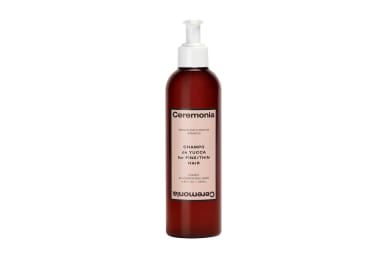Advertisement
The 6 Best Editor-Tested Shampoos For Oily Roots


Anyone who’s ever dealt with an oily scalp knows just how critical a well-formulated shampoo is. Of course, shampoo a staple in most folks' hair care routines, but for those with greasy roots, using the right product can make all the difference. I should know, I have very fine hair that gets weighed down easily. The second my scalp gets oily, it’s abundantly noticeable.
To find a solution, I’ve been testing out balancing shampoos to see if they can help keep my roots lifted and clean between washes. I will get into the specifics of my testing soon, but as an overview: I looked for shampoos that were cleansing but not stripping, didn’t dry out or damage my strands, were clean and natural, and sulfate-free.
Of my testing, here are the top formulas I’d happily give my stamp of approval.
A quick look at the best shampoos for oily hair
- Best overall: Briogeo Superfoods Mango + Cherry Oil Control & Balancing Shampoo ($30)
- Best for fine hair: Ceremonia Weightless Hydration Shampoo for Fine/Thin Hair ($20)
- Best for irritated scalp: Aveda Scalp Solutions Balancing Shampoo ($38)
- Best rinse: dpHue ACV Hair Rinse ($37)
- Best for daily use: Act & Acre Cold Processed Hair Cleanse ($32)
- Best silicone free: JVN Full Shampoo ($21)
How we tested the best shampoos for oily hair
The mindbodygreen beauty team rigorously tested shampoos on this list, and judged them on the following criteria.
- Efficacy: First and foremost, the formula should clean at the root and help balance oil between washes.
- Experience: We evaluated the product’s sensorial appeal based on the formula's consistency, spreadability, ease of use, lather (if applicable), and how it rinsed out.
- Non-drying: It’s important that the formula not dehydrate or damage the hair fiber, so we only included formulas that infused light-weight hydration into the washes.
- Ingredients: All of the formulas on this list are sulfate-free, clean, and include natural extracts. We judged the formulas based on what cleansing agents they used, as well as extra actives. Here, we also explained if it had fragrance, and if so, if we enjoyed it.
Superfoods Mango + Cherry Oil Control & Balancing Shampoo by Briogeo
I fell for this formula at first lather: It has the perfect balance of lightweight hydration, thorough cleanse, sensorially appealing lather, and long lasting oil-control. Essentially, it’s everything you want in a shampoo for oily roots. I use this shampoo when I want some serious lift at my roots and staying power (read: when I want my blowout to last several days).
Efficacy: 5
Efficacy: 5
This uses gentle, yet deep cleaning plant-derived surfactants that breakdown oil and buildup at the roots. I loved how easy the lather worked into the roots, so I could make sure the product got to all the harder to reach places, like the back of the head, where lots of people have buildup.
But what makes this formula uniquely effective is the papaya enzymes. Enzymes break down dead skin cells, offering a very gentle exfoliation. I often experience buildup, but sometimes find scalp scrubs to feel too harsh—this is the perfect inbetween.
Final note: I also love that this helps me stretch the time between washes. Because it’s getting rid of the dead skin cells, I find that I don’t need to shampoo as frequently, since my buildup isn’t as intense.
Experience: 5
Experience: 5
This has one of the best lathers I’ve ever felt from a sulfate-free shampoo. Truly: You’d mistake it for a conventional shampoo if you didn’t know.
The formula has a smooth consistency and easy slip, so I had no trouble working it throughout my scalp. Often, folks have oily scalps because they’re simply not getting the product to where it needs to go or work it into the roots enough. That’s why a a malleable formula is so important, as it makes application more user friendly.
I found the overall scent to be playful, if young. It has notes of juicy mango, bright citrus, and fresh florals. I didn’t find the scent to linger on the strands, which is a positive for me as I am quite sensitive to overpowering fragrance.
The rinse out isn’t cumbersome, and leaves no residue. About as effortless a cleanse as you can get outside of a professional blowout.
Non-drying: 4
Non-drying: 4
When I first used it, I was afraid it was going to be too drying of the strands. And while it does offer a deep clean, the lightweight hydration really sinks into the hair fiber.
Since my strands are very dry and damage prone, I personally follow it with a thick hair mask (focusing only at the ends). This combo makes my strands feel so soft and smooth after. However, someone whose hair is less fragile will likely be fine with a lighter conditioner.
Ingredients: 4.5
Ingredients: 4.5
Overall this formula delivers a smart blend of botanicals that deep clean the hair, while infusing moisture and antioxidants. Plus the addition of fruit enzymes removes dead skin cells.
- Plant-derived surfactants in the form of Cocamidopropyl Betaine and Sodium Lauroyl Methyl Isethionate.
- Conditioning plant oils, such as: Sunflower seed oil and carrot seed oil
- Papaya enzyme: Enzymes are tiny molecules found in fruits that break down the proteins in dead skin cells. They get rid of those dead skin cells at the surface of the skin, but they don't affect living cells underneath.
- Mango extract & juice: Mangos are high in vitamin C and E, antioxidants that protect hair from free radical damage.
- Cherry extract: A powerful antioxidant that also contains hydrating sugars.
- Free from: Parabens, phthalates, silicons, DEA, artificial dyes, formaldehyde or formaldehyde releasers, oxybenzone and octinoxate, hydroquinone, triclosan, coal tar, methylisothiazolinone and methylchloroisothiazolinone, and insoluble plastic microbeads.
- Note: It does contain an undisclosed fragrance
Pros & Cons
Pros & Cons
- 93% naturally derived formula
- Papaya enzymes dissolve dead skin cells on the scalp
- A lot comes out of the bottle
- Contains undisclosed fragrance
Ceremonia Weightless Hydration Shampoo for Fine/Thin Hair by Ceremonia
Fine, thin hair and oily roots go hand-in-hand. I should know, I have very fine hair. The explanation is fairly straightforward: There’s less hair to absorb the oil, and not as much volume to help mask any grease.
And this shampoo takes hair from weighed down to weightless. Our reviewer, beauty editor Jamie Schneider, notes: “Weightless is just the right word for this shampoo. When I use it, my strands feel fluffy, clean, and light as air. This is the shampoo that made me realize the importance of a proper cleanser for silky hair. Since testing it, my strands have never felt softer. I’m obsessed! “
Efficacy: 4
Efficacy: 4
Schneider notes that she only washes weekly, and found it to be cleansing enough: “My scalp definitely feels refreshed after washing, yet it doesn’t feel tight or stripped dry. I only wash my hair once or twice a week, but I don’t think you would have a problem using this every day (if you already follow a daily wash schedule). If I have tons of buildup, though, I do find I need to double cleanse.”
Experience: 4.5
Experience: 4.5
Overall, the in-shower experience was enjoyable, notes our reviewer. “It foams quite well for a sulfate-free shampoo! I usually use a scalp brush to work the product into a lather, but I didn’t even need to do that with this shampoo. Just make sure to rub it aggressively between wet palms before applying.”
For those who want to consider scent a vital part of the hair care experience, rest assured: This one’s a hit: “The fragrance is AMAZING. If you have a sensitive scalp I might recommend a different fragrance-free formula, but I think it’s delicious. Like light, fruity guava,” she told me.
Non-drying: 4
Non-drying: 4
Even though our reviewer notes she doesn’t use it daily, she says it’s hydrating and gentle enough for daily use should you need to. “For a shampoo with such a nice lather, that’s saying something.”
Ingredients: 5
Ingredients: 5
This botanical blend uses the plant witch hazel, which is often used for its oil-balancing properties.
- Plant-derived surfactants, such as Sodium Lauroyl Methyl Isethionate, Cocamidopropyl Betaine, Sodium Methyl Oleoyl Taurate, and Sodium Cocoyl Isethionate
- Witch hazel: Known for balancing sebum on the scalp and keeping flakes at bay
- Yucca extract: This plant contains natural saponins (aka gentle surfactants) that have cleansing properties
- Aloe vera: Aloe vera hydrates the strands and soothes the scalp
- Guava fruit extract: Provides a boost of hydration and antioxidant protection
- Pea-based amino acids (plant-based “keratin”): Supports the scalp and hair follicle, creating an environment for healthy hair growth
- Free from: Parabens, phthalates, silicons, DEA, artificial dyes, formaldehyde or formaldehyde releasers, oxybenzone and octinoxate, hydroquinone, triclosan, coal tar, methylisothiazolinone and methylchloroisothiazolinone, and insoluble plastic microbeads.
- Contains an undisclosed fragrance
A bonus, says our reviewer: “The ingredient list is supported by ClearForMe, which makes decoding much easier—I’ll give the brand bonus points for that!”
Pros & Cons
Pros & Cons
- Witch hazel has oil balancing properties
- Plant proteins can help strengthen the hair
- Strongly scented, so avoid if you have a sensitive scalp that reacts to fragrance
Aveda Scalp Solutions Balancing Shampoo by Aveda
A not so fun fact, but irritation can trigger excess oil production. When the barrier is compromised or there’s inflammation, it sends the oil glands into overdrive. That’s why it’s so important to balance the scalp, which helps solve the problem at the root (ahem, pun intended.) This gentle, cooling formula helps calm the skin—helping with oil in the long term.
Efficacy: 3.5
Efficacy: 3.5
If your oily roots come with irritation, flakes, dandruff, and tenderness, this is the product for you. It gets to work right away, thanks to the cooling sensation.
It’s formulated for daily use, so it’s not a deep clean like others on the list. If you’re looking for a real reset, you may benefit from something that’s more clarifying.
My scalp is fairly sensitive, especially if I have excess buildup from styling products, dry shampoo, or grease. If I go too long between washes, my scalp feels tender. So I love using this when I need something that can help calm the skin, while getting in there and removing debris. A bonus: When I’m using this, I find my hair stays fresher between washes.
I personally don’t suffer from an itchy scalp, but lots of reviewers say it’s the only thing that relieves their uncomfort.
Experience: 4
Experience: 4
The cooling sensation feels amazing—especially if you’re dealing with any itching, tightness, or patches. It really provides instant relief!
It doesn’t have the most sensorially appealing lather—it’s a bit lacking—but I don’t find it to be a deal-breaker, as the main draw is the cooling.
Non-drying: 4
Non-drying: 4
As far as hydration goes, I’d say it’s pretty middle of the road. It’s a gentle cleanser that doesn’t strip too natural hydration away, nor is it deeply moisturizing. It’s balanced, if you will.
Ingredients: 5
Ingredients: 5
One of the leaders in clean, natural hair care, it’s no surprise that Aveda’s formulas are quality.
- Plant derived surfactants such as Sodium Cocoyl Isethionate, Sodium Methyl Cocoyl Taurate, and Babassuamidopropyl Betaine
- Propanediol: Otherwise known as vitamin B5, this ingredient acts as both a hydrator and antioxidant
- Glycerin: This humectant can help hydrate both the scalp and hair fiber
- Lactobacillus Ferment: As a postbiotic, this extract helps balance and nurture the scalps microbiome
- From: Animal derived ingredients, sulfates, silicones, phthalates, parabens, mineral oil, petrolatum, formaldehyde & donors, paraffin, synthetic fragrance, microcrystalline wax, coal tar, triclosan and triclocarban
- Natural fragrance made from extracts and essential oils, such as lemon, neroli, and mint
Pros & Cons
Pros & Cons
- 94% naturally derived formula
- 100% wind & solar powered manufacturing
- 100% PCR PET bottles
- Not as lush lather
To clarify: This is not a shampoo. Rinses are designed to compliment your wash schedule, helping you stretch the time between shampoos and balance oil production. They’re supplemental products, not replacements. And for oily haired folks, they’re a total gamechanger. Rather than shampooing daily, swap a few of those for this rinse: It’ll help refresh the roots, balance the oil, and help manage oil-production long term.
I love using dpHUE’s cult classic rinse between washes as a style refresher, and have for years. It’s one of my all-time favorite products. Assistant beauty editor Hannah Frye agrees, “This product is designed to be used supplemental to other shampoos and for that purpose I love it. This helps oily-prone roots feel refreshed without a full shampoo. It filled a gap in my routine.”
Efficacy: 5
Efficacy: 5
I’m judging this product on a different scale than the others, considering it’s a rinse and not a conventional shampoo. Essentially: This won’t suds or leave the hair feeling squeaky clean.
But for what it does, it’s the best at its job. This formula uses apple cider vinegar, which has astringent properties to help remove dead skin cells and excess oil, rather than surfactants or sulfates. It also seals the cuticle of the hair fiber
“After utilizing this rinse, I stay away from sticky dry shampoos. Rather than wash my oily hair everyday or every other day, I stick with one shampoo a week when using this in between. It extends your time between a true shampoo. It really is a game-changer,” says Frye.
Experience: 3
Experience: 3
Given I’ve been using rinses for years, I have no problem with the sensorial experience. But if I were to put myself in the shoes of someone new to this, it is a deviation from the norm—and may take some getting used to. “Don’t get your hopes up for a shampoo-like finish because it won’t happen that way, it refreshes the hair but doesn’t make it feel squeaky clean,” notes Frye.
Here’s how it works: After wetting your hair and scalp, use the tip of the bottle to work the product in small sections throughout the hair. Squeeze the bottle gently, so not too much formula comes out. Massage the product into the scalp, and rake it through the strands. Rinse thoroughly after.
Oh, and to note the scent: “I’ll admit the scent is a bit odd given it’s a pretty natural formula with ACV in it. Still, I’d rather have that than a strong artificial fragrance to mask it and potentially irritate the scalp,” says Frye.
Non-drying: 5
Non-drying: 5
Given the nature of the product, it definitely doesn’t strip the strands—there are no surfactants or sulfates to do so! Rather the ACV rebalances the scalp, redistributes oil, and refreshes the style.
“Most definitely non-stripping! Helps to moisturize your scalp and refresh your strands but never leaves your hair feeling dry,” notes Frye.
Ingredients: 5
Ingredients: 5
This natural-leaning formula blends together a variety of hair-supporting botanical ingredients to balance oil.
- Apple cider vinegar: Balances pH, balances oil, increases shine, gently exfoliates the scalp, and extends time between washes.
- Argan oil: A botanical oil full of fatty acids and antioxidants. Helps condition the strands.
- Aloe vera: Aloe vera hydrates the strands and soothes the scalp.
- Lavender extract: Calms the scalp
- Free of: Sulfates, surfactants, parabens, phthalates, gluten, formaldehyde & donors, paraffin, synthetic fragrance, microcrystalline wax, coal tar, triclosan and triclocarban
Pros & Cons
Pros & Cons
- Ingredient traceability: Artisanal crafted Apple Cider Vinegar from George Paul Vinegary
- Can extend the life of color treatments
- Strong, somewhat unpleasant smell (from the ACV)
- Not silicone free (if you avoid all silicones)
Act & Acre Cold Processed Hair Cleanse by Act + Acre
The mindbodygreen beauty team is big fans of the brand Act & Acre. The formulas are serious about caring for the scalp, and infuse skin care quality ingredients into the products (they’re all designed by a certified trichologist and hair stylist, Helen Reavy). And this shampoo is a classic. It’s intended for use daily—or every other day—which many folks with oily roots feel they need. If you are going to shampoo that regularly, it’s very important to find an option that won’t irritate the scalp or dehydrate the strands. This does just that to perfection. As one of our reviewers Schneider notes, “This is high on my list of my all-time favorite shampoos. It lathers like a dream, effectively lifts buildup, and doesn’t leave my scalp parched dry.”
Efficacy: 4
Efficacy: 4
Given it’s intended for daily use, it’s not as strong of a power wash like other options on this list (i.e. JVN Embody Volumizing Shampoo, which is closer to a clarifying shampoo than conventional one). But it’s still pretty great at lifting off buildup and dissolving oil. As Schneider notes, “This is the shampoo I turn to when I have loads of buildup. Greasy days are no match for the Hair Cleanse.”
Experience: 5
Experience: 5
The lather is my favorite part of the experience. It’s a dense, soft foam—the kind with tiny bubbles and a rich texture. It’s a treat to apply it all over the scalp. Schneider agrees: “Very impressive lather! It doesn’t take much work at all for it to bubble into a foam.”
When I apply it, I do it exactly as Reavy taught me: I work it throughout my scalp in sections. Lots of folks apply shampoo directly to the crown, which makes it hard to spread out and coat the skin evenly. So when you work in smaller doses in sections
The fragrance is from a combination of essential oils, such as cedarwood, ylang-ylang, and cardamom. It’s elevated, but not overpowering. As Schneider notes, “The fragrance It’s a nice scent! I personally enjoy other shampoo fragrances better (I prefer something fruitier), but it smells clean and fresh.”
Non-drying: 4
Non-drying: 4
I personally found this to be comparable to the Briogeo shampoo: It was a thorough cleanse for the scalp, and my strands were fine as long as I followed up with a rich conditioner. As Schneider said, “I have noticed my hair feeling dry before piling on the conditioner. So I try not to saturate my lengths with the shampoo, but sometimes it just happens.”
It is buffered with conditioning ingredients, such as baobab oil and glycerin to help buffer any dryness.
Ingredients: 4.5
Ingredients: 4.5
Skin care quality ingredients make this formula a standout.
- This uses surfactants from apple amino acids, which cleanse without irritation
- Additional plant-derived surfactants, such as Sodium Lauroyl Methyl Isethionate and Lauramidopropyl Betaine
- Glycerin: This humectant can help hydrate both the scalp and hair fiber
- Baobab oil: A conditioning plant oil rich with fatty acids and antioxidants
- Free from: Parabens, phthalates, silicons, DEA, artificial dyes, formaldehyde or formaldehyde releasers, oxybenzone and octinoxate, hydroquinone, triclosan, coal tar, methylisothiazolinone and methylchloroisothiazolinone, and insoluble plastic microbeads.
- Fragrance made with essential oils — so avoid it if you're sensitive to them.
Pros & Cons
Pros & Cons
- Cleansing ingredients derived from apple amino acids
- Large bottle
- Safe for daily use
- Contains essential oils if you're sensitive
This is a mix between a clarifying shampoo and a hair growth shampoo—so it’s ideal for those who want a boost in volume. Not only will it give you a temporary lift at the roots (thanks to the deep clean), but the caffeine can help stimulate healthy hair growth in the long run.
Efficacy: 5
Efficacy: 5
If you’re after a big, full-bodied blowout, this is the shampoo to start with. It uses a concentrated combination of plant-derived cleansers that power through oil buildup, dirt, and products. My hair was the cleanest it’s felt in a long time after I tested it.
While I didn’t test it long enough to really judge it, it’s also infused with a caffeine extract. Caffeine is an excellent ingredient for hair growth products, as it stimulates circulation at the root. According to a report in the International Journal of Trichology, caffeine has the ability to stimulate the scalp and provides antioxidant properties, which can help reduce hair shedding.
I also love that the brand uses a natural silicone alternative, that conditions and smoothes the hair—sans damage or buildup. In fact, the brand notes that it can reduce breakage by 51%. When I use it, I notice less hair fragments in my hands post rinse.
Experience: 4
Experience: 4
The lightweight gel formula builds into a comfortable foam, and easily spreads throughout the hair. I was able to work it in throughout the scalp quite efficiently. It rinsed out quickly, and left no residue.
I loved the sophisticated, light scent—probably because it contains some of my favorite fragrance notes, such as bergamot, jasmine, and sandalwood.
Non-drying: 2
Non-drying: 2
While this contains hydrating ingredients (hello, aloe vera!) this leans closer to a clarifying shampoo than a traditional formula. Read: It deep cleans the scalp and roots, but I found it to be slightly drying. This was remedied by following it with a deep conditioner and rich leave-in, but I’m not sure I personally could use this as a daily shampoo.
Ingredients: 5
Ingredients: 5
This lightly clarifies the scalp, protects and smooths the strand with squalane, and boosts hair growth with caffeine.
- Plant-based surfactants, including Sodium Methyl Cocoyl Taurate, Sodium Lauroyl Methyl Isethionate, Cocamidopropyl Hydroxysultaine
- Hemisqualane: This silicone alternative is made with sugarcane derived squalane, which smooths the cuticle, conditions the hair fiber, and protects the hair from breakage.
- Caffeine: Caffeine can boost circulation to the scalp, which encourages healthy hair growth. One 2018 study shows that a caffeine-based liquid topical can be just as effective as Minoxidil, active in brands like Rogaine and the traditional topical treatment for hair loss.
- Aloe vera: Aloe vera hydrates the strands and soothes the scalp.
- Free from: Parabens, phthalates,silicons, DEA, artificial dyes, formaldehyde or formaldehyde releasers, oxybenzone and octinoxate, hydroquinone, triclosan, coal tar, methylisothiazolinone and methylchloroisothiazolinone, and insoluble plastic microbeads.
- Fragrance is natural and synthetic blend of bergamot, sandalwood, jasmine, and amber
Pros & Cons
Pros & Cons
- Contains a natural silicone alternative, hemisqualane
- Bottle is made with 100% infinitely recyclable aluminum, post consumer recycled pump, and FSC certified with soy-based ink otterbox
- Sells out often
- Bottle can dent & leak in transit
mbg’s POV on clean and natural formulas
There is no regulated definition of "clean" or "natural" in the beauty industry. So it's really up to brands, publications, and individuals to create their own definition.
Natural ingredients are plant- or mineral-derived and are extracted from natural-world sources. We prioritize natural ingredients when they make sense in the formula, as many botanicals are hugely beneficial for the skin. (A few below!)
But we also understand that lab-derived ingredients can sometimes be the better alternative, as they can be more environmentally friendly and less irritating for the skin. We also believe that "natural" formulas are a spectrum, as it's very rare that a product is 100% natural—so a natural formula may still contain ingredients that are synthetic.
Clean formulas can include both natural and lab-derived ingredients. Clean ingredients are those that are identified as safe for the skin and overall health as backed by research. Clean formulas tend to be more gentle for skin, as they avoid sensitizing ingredients. We believe that what ingredients are deemed "safe" is an ongoing conversation.
Why you should trust us
As mindbodygreen's beauty director who has been in the industry for about a decade, I've tested hundreds of products over the years. As a thorough reporter, I stay informed on the latest ingredient research and innovations.
The beauty industry is a dynamic, continuously evolving space, and it's important to stay up-to-date in order to make informed choices about which formulas earn a spot on this list. The ones I recommend to you are rigorously tested, vetted, and researched. High standards are earned—and there are no shortcuts.
In addition, many of the options on this list have been tested with the mbg beauty team as well—so multiple opinions help inform this list.
What causes oily scalps
As with your skin, there are several factors that contribute to increased oil production on the scalp. Ultimately, too, there's a good chance it's a combination of influences that are triggering your oil abundance.
Here’s a quick overview of the causes, but you can read more in-depth about it in our guide to oily scalps.
- Overwashing: Being overzealous with your wash strips the scalp and tricks it into thinking it's dry. This, in turn, spurs the sebaceous glands into overdrive, which then makes your hair produce more oil faster. That’s why it's important to find a non-stripping, sulfate-free shampoo, as well as find your ideal wash day schedule. (More on that in the next section.)
- Underwashing: While you shouldn't overwash, you shouldn’t skip it entirely. Just like face wash is the basis of a solid skin care routine, cleaning your scalp is the foundation for healthy hair.
- Conditioner mis-use: Conditioner should be applied no further than a quarter away from the root. Start at the end, generously applying product in the area, as it lacks moisture and oil. Work the product up the strands until about a few inches away from the scalp.
- Product buildup: Product buildup from leave-ins, styling products, dead skin cells, and dirt can lead to a greasy appearing scalp. Product buildup can also trigger inflammation, which leads to increased oil production.
- Overstyling: When you style, and restyle, your hair between washes that increase the amount of times you’re applying heat and touching the hair.
- Stress: The stress hormone cortisol triggers oil production in the face and scalp.
- Hormones: Hormone imbalances can lead to increased sebum production, research shows. In fact, sebum production is controlled by hormones1, including testosterone, other androgens, progesterone, cortisol, and growth factors.
- Diet: Studies show2 that there's a connection between dairy—skim milk, primarily—and sebum. Other studies show a strong connection between foods with a high glycemic index and oil in the skin3.
- Hair type: Hair types play a big role in this discussion, as some are far more prone to oil build up than others. Most notably? Fine, thin hair that has minimal texture, such as straight or loose waves.
- Genetics: just like your face, your scalp can simply produce more oil than the average person. Typically those with oily facial skin will also have increased oil production the scalp.
How often should people with oily scalps wash their hair
Experts and consumers alike struggle with this because there's no exact equation that works for everyone all of the time. Our scalp and hair types have different needs—not to mention they are affected by the weather, what products you use, and your activity levels.
For those with oily roots or hair, however, a good rule of thumb is every 2-3 days.
However, several things might influence this cadence:
- Activity level: If you do high-intensity or sweat-inducing workouts, you may find that a daily wash is mandatory.
- Weather: Those in humid climates may find they need to shampoo more frequently.
- Dry strands: Some folks have combination hair (dry hair fiber, oily roots). This is a delicate balance as you want to clean the scalp, but don’t want to strip the hair of its protective oils. Error on the side of washing less frequently if possible.
- Flakes: Those with dandruff (seborrheic dermatitis) will likely need to shampoo more frequently, as it “helps wash away yeast and dead skin cells," says board-certified dermatologist Hadley King, M.D. Folks with flakes should also incorporate formulas with antifungal properties to help you deal with the flakes, like these salicylic acid or tea tree shampoos.
- Hair type: While those with type 1 and type 2 hair tend to be more oily, those with curly hair can also have oily roots. However, folks with curly hair tends to have drier strands, so aim for shampooing less frequently so as to not damage the hair fiber.
Read more in our guide to shampooing hair.
The takeaway
Just like a face cleanser is the backbone of a good skin care routine, a high-quality shampoo is the foundation for a healthy hair care routine. These options are the best for oil-prone roots and strands, as they effectively clean the scalp, are non-stripping, and feel great to use. Now, don’t forget to follow that up with one of our favorite conditioners.





